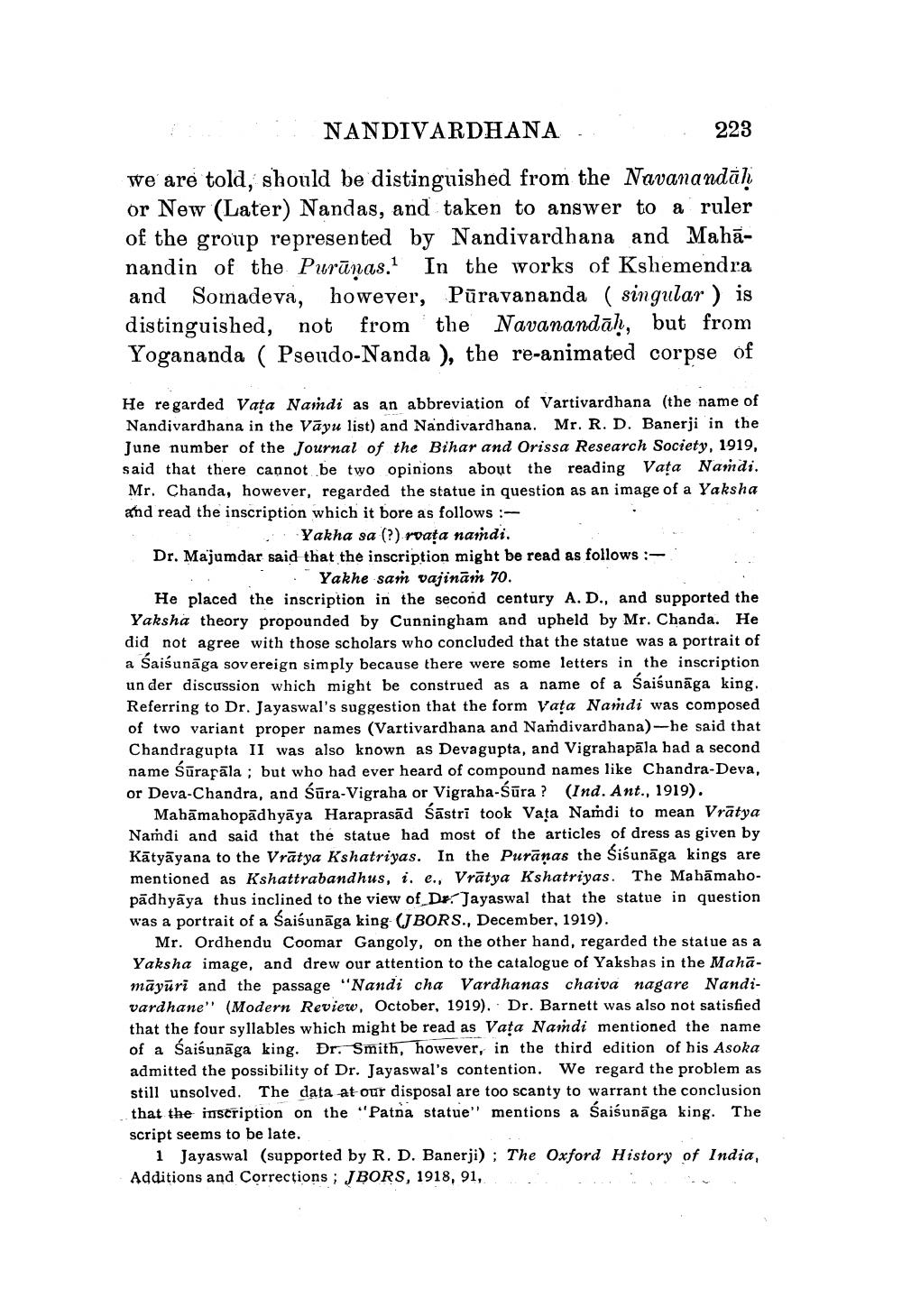________________
223
NANDIVARDHANA
we are told, should be distinguished from the Navanandah or New (Later) Nandas, and taken to answer to a ruler of the group represented by Nandivardhana and Mahanandin of the Puranas.1 In the works of Kshemendra and Somadeva, however, Pūravananda (singular) is distinguished, not from the Navanandah, but from Yogananda (Pseudo-Nanda ), the re-animated corpse of
He regarded Vața Namdi as an abbreviation of Vartivardhana (the name of Nandivardhana in the Vayu list) and Nandivardhana. Mr. R. D. Banerji in the June number of the Journal of the Bihar and Orissa Research Society, 1919, said that there cannot be two opinions about the reading Vata Namdi. Mr. Chanda, however, regarded the statue in question as an image of a Yaksha and read the inscription which it bore as follows:
Yakha sa (?) roața namdi.
Dr. Majumdar said that the inscription might be read as follows:
Yakhe sam vajināṁ 70.
a
He placed the inscription in the second century A. D., and supported the Yaksha theory propounded by Cunningham and upheld by Mr. Chanda. He did not agree with those scholars who concluded that the statue was a portrait of Śaisunaga sovereign simply because there were some letters in the inscription un der discussion which might be construed as a name of a Śaisunaga king. Referring to Dr. Jayaswal's suggestion that the form Vața Namdi was composed of two variant proper names (Vartivardhana and Naṁdivardhana)-he said that Chandragupta II was also known as Devagupta, and Vigrahapala had a second name Śūraṛāla; but who had ever heard of compound names like Chandra-Deva, or Deva-Chandra, and Śūra-Vigraha or Vigraha-Śūra? (Ind. Ant., 1919).
Mahamahopadhyaya Haraprasad Sastri took Vața Namdi to mean Vratya Namdi and said that the statue had most of the articles of dress as given by Katyayana to the Vratya Kshatriyas. In the Puranas the Siśunaga kings are mentioned as Kshattrabandhus, i. e., Vratya Kshatriyas. The Mahamahopadhyaya thus inclined to the view of Dr Jayaswal that the statue in question. was a portrait of a Saiśunaga king (JBORS., December, 1919).
Mr. Ordhendu Coomar Gangoly, on the other hand, regarded the statue as a Yaksha image, and drew our attention to the catalogue of Yakshas in the Mahamayuri and the passage "Nandi cha Vardhanas chaiva nagare Nandivardhane" (Modern Review, October, 1919). Dr. Barnett was also not satisfied that the four syllables which might be read as Vata Namdi mentioned the name. of a Saiśunaga king. Dr. Smith, however, in the third edition of his Asoka admitted the possibility of Dr. Jayaswal's contention. We regard the problem as still unsolved. The data at our disposal are too scanty to warrant the conclusion that the inscription on the "Patna statue" mentions a Śaisunaga king. The script seems to be late.
1 Jayaswal (supported by R. D. Banerji); The Oxford History of India, Additions and Corrections; JBORS, 1918, 91,




